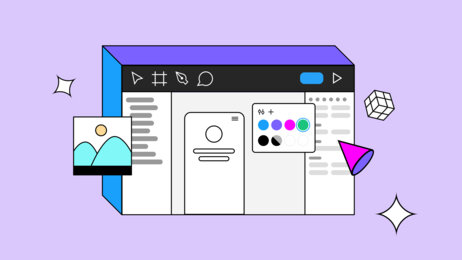
Justyna Bieryło
-
Oct 03, 2024
-
13 min read
Why a strong UX design portfolio matters
In the world of UX design, you have to prove yourself and your skills in a certain way. As you already know, the best way to do so is by creating an exceptional portfolio that will highlight your expertise. But, why exactly does it matter? Let’s review it.
Importance of portfolios in UX design hiring
In UX design hiring, a portfolio serves as a crucial tool for showcasing a designer's skills, creativity, and problem-solving approach. It provides potential employers with tangible evidence of how candidates think, design, and iterate on projects, going beyond just resumes and cover letters. A well-crafted portfolio allows designers to demonstrate their process, highlight real-world results, and show versatility in handling diverse challenges, which can significantly increase their chances of standing out in a competitive job market.
What hiring managers look for in UX portfolios
Hiring managers look for portfolios that effectively showcase a designer’s problem-solving abilities and design thinking process. They want to see how candidates approach user research, create wireframes, and iterate based on feedback. Strong portfolios highlight a variety of projects, demonstrating adaptability and versatility across different industries or design challenges. Clarity in case studies, with a focus on the impact and results, is key. They also value portfolios that balance visual aesthetics with functionality, reflecting the candidate’s understanding of both user experience and interface design. Make sure to design your portfolio so that it is easy and quick for recruiters to scan. Consider your audience, and keep in mind that recruiters are often short on time. It is crucial to present your portfolio in a way that allows them to grasp the key points quickly.
Defining the purpose of your portfolio
In a UX design portfolio, it’s essential to showcase not only your skills but also your thought process. This includes demonstrating how you approach design challenges, conduct user research, and iterate on feedback. Hiring managers want to see your reasoning behind design decisions, from concept to execution, and how you solve problems. By providing case studies and clear explanations, you can highlight your critical thinking, creativity, and ability to deliver effective, user-centred solutions.
Portfolio structure and key components
When creating your first UX design portfolio, there are a couple of things you should remember. For example, consider the overall structure and key components that should always be included. We will now go through each of them to ensure that you do not forget anything while crafting your first portfolio.
Case Studies – in-depth analysis of design projects
Case studies are the heart of a UX portfolio, offering in-depth analyses of specific design projects. These should detail the entire design process, from identifying the problem to delivering the final solution. Effective case studies include user research, wireframes, iterations, and usability testing. By walking through each stage, you demonstrate your problem-solving skills, design thinking, and the impact your work had on users or the business. Highlighting challenges faced and lessons learned gives insight into your adaptability and growth as a UX designer.
Design Process
A well-rounded UX portfolio should walk the viewer through your design process, showcasing your UX thinking. Even if you were involved in the first steps of the project, and not all of them, include it in your portfolio. Start by detailing how you conduct user research, and gathering insights to define user needs. Then, highlight how you create wireframes and low-fidelity prototypes to explore initial ideas. Finally, demonstrate your skills in iterating and refining designs through interactive prototypes, showing how you improve usability and overall experience.
Visuals and prototypes – how to include engaging, high-quality visuals
High-quality visuals are crucial in a UX portfolio to effectively communicate your designs. Ensure you present clear, crisp images of wireframes, mockups, and final prototypes, providing context around each one. Use interactive prototypes or short videos to demonstrate user flows and interactions where possible. By focusing on both the aesthetics and functionality of your visuals, you help hiring managers and clients understand the full scope of your work, showing not just what you designed but also how it works.
Contact information – ensuring easy communication
Your portfolio should make it easy for hiring managers and clients to contact you. Ensure your contact information is prominently displayed, typically in a footer or a dedicated "Contact" section. Include multiple ways to reach you, such as an email address, LinkedIn profile, and any relevant social media or professional networks. A contact form can also be useful to streamline inquiries. Accessibility is key to ensuring interested parties can connect without hassle.
About me section – communicating your background and expertise
This section of a UX portfolio is an opportunity to communicate your background, expertise, and personal approach to design. This section should offer a brief but engaging overview of who you are as a designer, highlighting your key skills, relevant experience, and what drives your passion for UX. It’s also a chance to share your unique value proposition, what sets you apart, and perhaps a bit of your personality, creating a connection with potential employers or clients on a personal level.
Selecting and presenting projects
Now that you know what to include in your portfolio, it is finally time to select your projects. This might be the hardest step, especially if you have worked on multiple projects for various companies. So, how do you decide?
How to choose projects
When selecting projects for your UX portfolio, focus on showcasing variety and relevance. Choose projects that are the most important for you and are from the industry that you would like to continue to work in. Also, those projects should highlight your range of skills, from user research to high-fidelity prototypes. Prioritise projects that reflect real-world impact, where you solved tangible problems or improved user experiences. Highlighting different industries or design challenges can show your adaptability. It’s essential to include a few key case studies that deeply explore your design process and demonstrate your growth as a UX designer.
Tailoring portfolios for specific roles or industries
To maximise your portfolio’s impact, tailor it to the specific roles or industries you’re targeting. For example, if applying for a role in e-commerce, highlight projects that showcase user journey optimisation or checkout flows. For a healthcare industry role, emphasise designs that solve for accessibility and user trust. This targeted approach helps demonstrate your expertise in relevant areas, making you a more attractive candidate for specialised roles. Customising your portfolio shows a deep understanding of industry needs and the ability to adapt your design approach accordingly.
Tools and platforms for building a portfolio
Now, let's focus on something that can really help you when it comes to the creation process and showcasing your portfolio. Namely, some of the most popular platforms and tools.
Overview of popular platforms
Popular platforms like Behance and Dribbble offer designers a ready-made space to showcase their work within a design community. Behance allows for detailed project breakdowns, making it ideal for case studies, while Dribbble focuses on snapshots of visual design. For a more customized and professional touch, many designers opt for personal websites, offering complete control over layout, branding, and content. Personal sites also allow for integrating unique elements like interactive prototypes, making them ideal for demonstrating versatility and creativity.
Tips for showcasing interactive prototypes
Interactive prototypes are essential for demonstrating user flows and interactions in a UX portfolio. Tools like Figma allow you to create clickable prototypes that mimic real user experiences. When showcasing these, provide embedded links or videos to demonstrate the functionality directly in your portfolio. Use tools like Figma's embed feature to make prototypes accessible. Highlight key interactions, transitions, and user feedback to give potential employers a clear sense of how your designs function in a real-world context.
Common mistakes to avoid
As for everything that we do throughout our lives, there are certain mistakes that we all should avoid in order to be more successful, right? Well, the same thing goes for creating a UX designer portfolio, and now we will focus solely on them. Let's dive straight in.
Overloading with too many projects
Including too many projects in your UX portfolio can dilute the impact of your best work. Rather than overwhelming viewers, focus on quality over quantity by highlighting a select few projects that showcase your strongest skills and deliver the most value. Each project should tell a compelling story and provide depth, so avoid padding your portfolio with less relevant or unfinished work. A concise, well-curated portfolio leaves a stronger impression and better communicates your expertise.
Lack of context or rationale in design decisions
A portfolio without context or rationale for design decisions can leave viewers confused about the thought process behind your work. It’s essential to explain the "why" behind each choice, from research findings to user flows, to demonstrate your strategic thinking. Describe the problems you aimed to solve and how your design choices addressed specific user needs. Providing this insight not only highlights your design process but also shows that your decisions are grounded in user-centred thinking.
Summary
To stand out in the crowded field of UX design, focus on clarity, creativity, and a well-organized portfolio. Prioritize quality over quantity, and ensure that each project tells a compelling story. Include metrics or real-world impact to add credibility to your work. Tailor your portfolio for specific roles, and keep it updated regularly with new projects or skills. Lastly, maintain a balance between aesthetics and usability—your portfolio should be a reflection of your UX expertise.
Your UX portfolio is a prime opportunity to establish personal branding, making you memorable to potential employers or clients. Infuse your portfolio with your unique design philosophy, values, and approach, whether through a distinct visual style or the tone of your case studies. Consistency in branding, from your portfolio to your LinkedIn and resume, reinforces your identity as a designer. Strong personal branding helps you stand out and create a lasting impression in the minds of viewers.



















